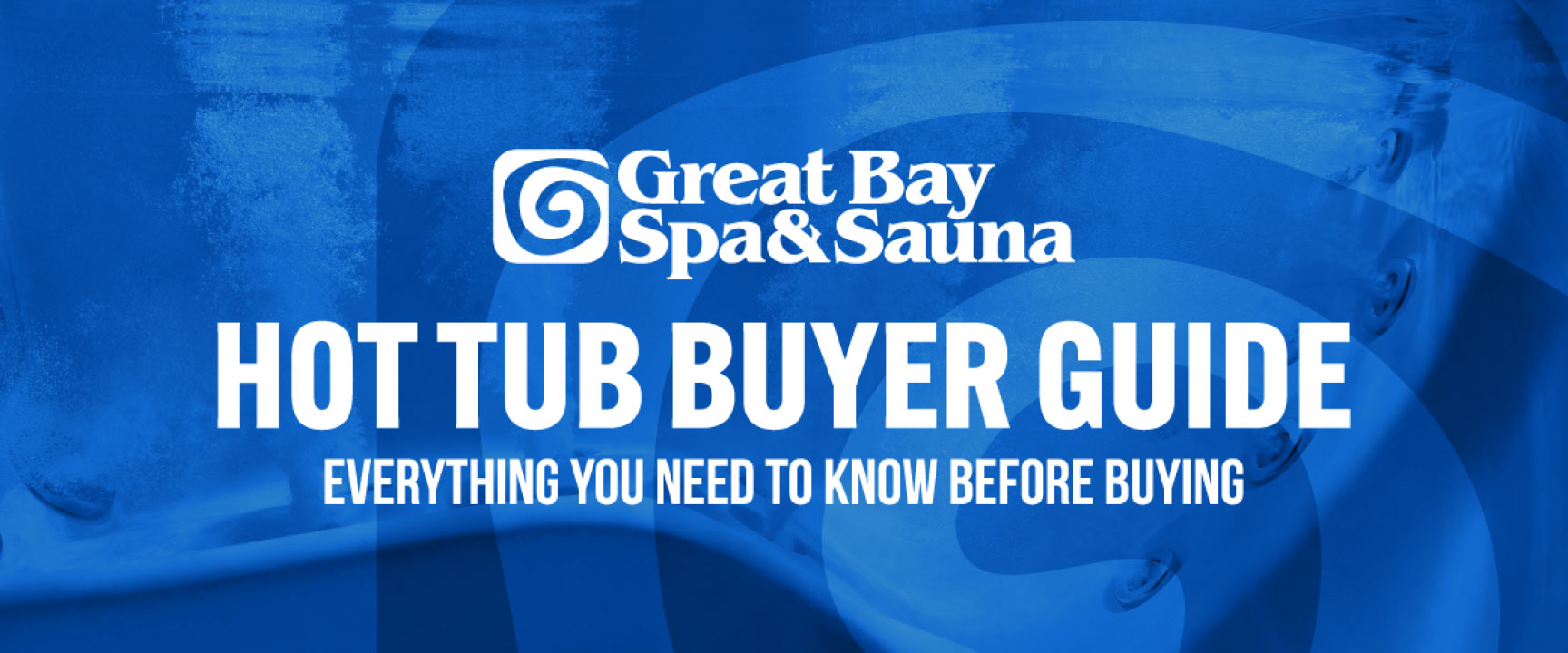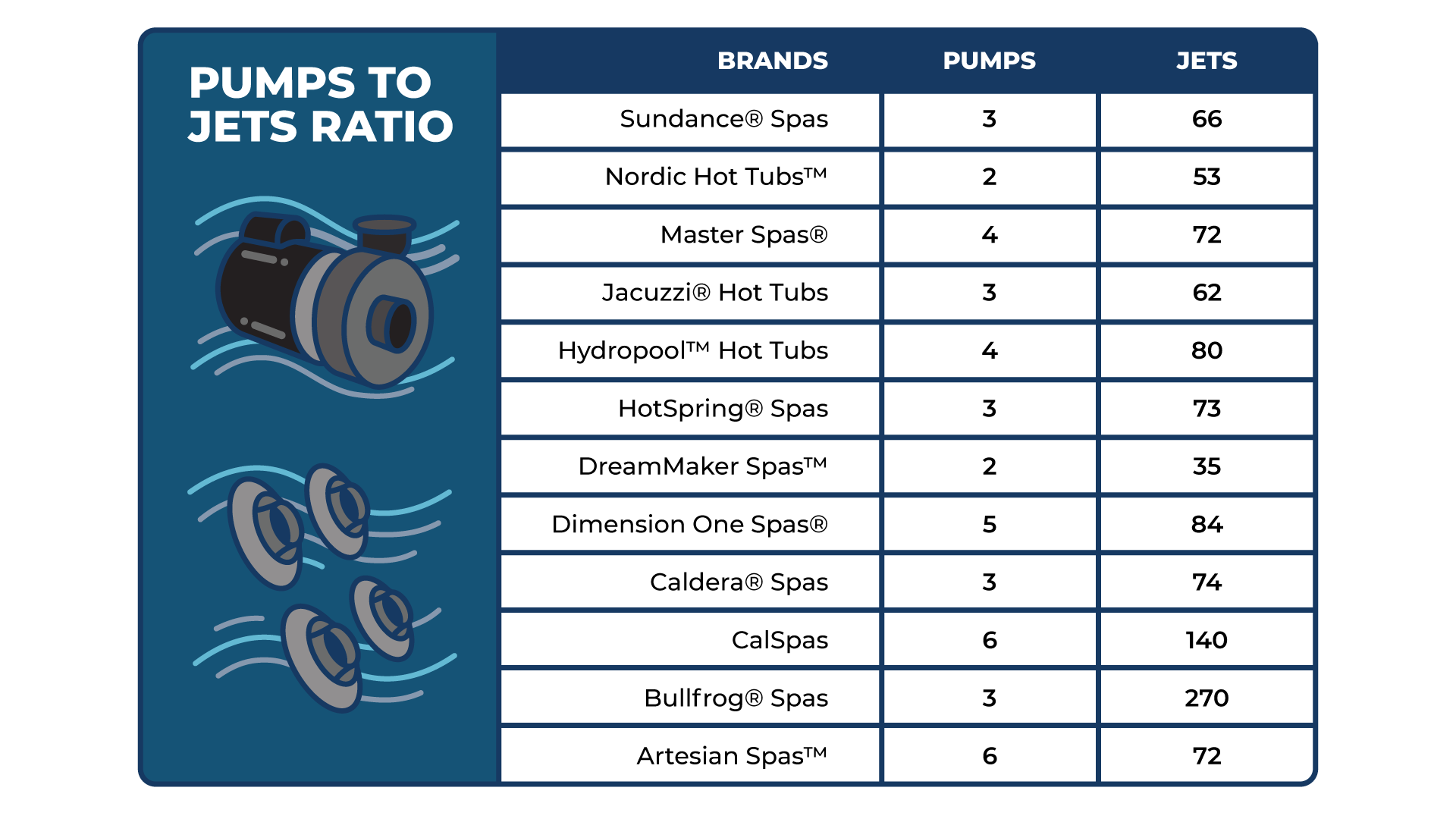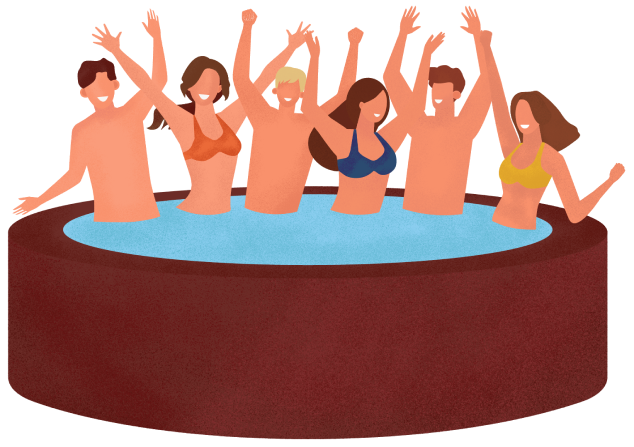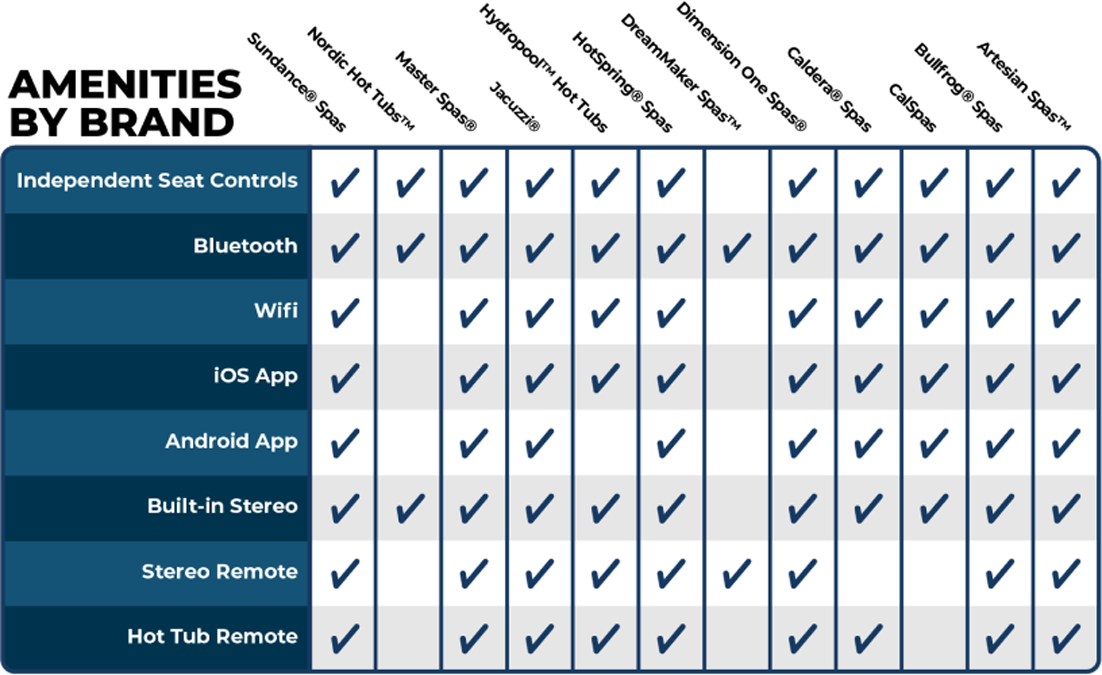
Hot tubs offer numerous benefits, from relaxation and stress relief to improved physical and mental health. You’re in the right place to start your hot tub buying journey and discover the perfect hot tub for you and your home. We understand that purchasing a hot tub can be overwhelming, which is why we have created this comprehensive resource to help you make an informed decision. Our Buyer’s Guide offers a plethora of information about what to look for when buying a hot tub, from size and style to features and benefits. Whether you’re a first-time hot tub buyer or a seasoned spa-lover, our guide will provide you with the knowledge you need to choose the perfect hot tub for your needs. So take your time, browse through our guide, and discover the world of hot tubs!

Choosing a dealer is an important step in the hot tub buying process. You want a hot tub dealer who possesses extensive knowledge in the field, boasts a dependable reputation and can provide valuable assistance throughout the entire lifespan of the tub. If you want to gauge a dealer’s expertise, a helpful approach is to consider how long they’ve been selling their brand(s). The longer they’ve been in the industry, the more knowledge they’re likely to have amassed over time.

When shopping for a hot tub, it’s crucial to factor in the quality of both construction and materials used. High-quality construction and materials will not only provide a more visually appealing hot tub, but will also ensure durability, longevity, and safety. On the other hand, poor construction and low-quality materials can result in a hot tub that is more prone to breakdowns and leaks. Plus, they can make servicing the tub difficult or even impossible.

Before purchasing a hot tub, it’s important to identify your priorities as it can be a significant investment in terms of finances and space in your home. Factors such as the size of the hot tub, the type of jets, the filtration system, and the overall design and aesthetic should all be considered. If you have a large family, a hot tub with plenty of seating may be a priority. If you have limited backyard space, a smaller hot tub may be a better option. By understanding your priorities, you can make a more informed decision and pick a hot tub that’ll cater to your needs. This way, you can enjoy a relaxing and delightful spa experience for many years to come.
It’s recommended to wet test multiple hot tubs to find the one that suits your needs and preferences the best. Most hot tub dealers have various models in their showrooms for you to try.

Picking the perfect hot tub involves considering where you want to put it. Knowing the location can help you decide on the size and type that’ll best meet your needs. For instance, if you’re placing it on your deck or patio, you need to ensure the area can hold the weight and that it’s accessible. Additionally, placing your hot tub near a door or bathroom can also make it more convenient to use and maintain, as you’ll have easy access to towels, robes, and other necessities. But, if you’re placing it indoors, you need to have adequate ventilation to prevent moisture buildup and guarantee that it can be safely and quickly installed. Moreover, pinpointing the location will enable you to factor in things like privacy, electrical and plumbing requirements, and accessibility for maintenance and cleaning.

It’s also important to think about the long-term aesthetics of your hot tub. Sure, a hot tub is a functional and enjoyable addition to your home, but it’s also a visual statement that can impact the overall look of your outdoor space. Therefore, it’s important to pick a hot tub that complements your home’s style and architecture and maintains its visual appeal for years to come. This may involve mulling over colors, materials, and designs, as well as its location.
Hot tubs offer a wide range of features that can help elevate your spa experience to the next level. In the following section, we will explore some of the most popular features to help you make an informed decision when looking for your perfect hot tub.

Pumps play a critical role in the functioning of a hot tub. They circulate water through the filter and heater and power the jets. A high-quality pump ensures that the hot tub’s jets provide the right amount of water pressure, resulting in a more relaxing and enjoyable spa experience. Not to mention, pumps also affect the hot tub’s energy efficiency, which impacts operational costs. This is why it’s important to choose a hot tub with a reliable and high-quality pump that guarantees effective water circulation, ensuring a safe and enjoyable spa experience.
Single-speed pumps are the most basic and affordable type of hot tub pump. They operate at a fixed speed and can perform a variety of functions such as powering the jets, circulating water through the filtration system, and heating the water. While they are easy to maintain, single-speed pumps are the least efficient, which means they could increase your energy costs in the long run.
A two-speed pump is a variation of the single-speed pump because they both use an induction-style motor. The difference is that a two-speed pump has a low-speed option, which is more versatile and efficient compared to solely running the pump at high speed. Having the low-speed option also means you may be able to use just one pump to run your entire hot tub—saving you money in the long run and providing you with a more customizable spa experience.
Variable-speed pumps are an advanced type of hot tub pump. They use permanent magnet motors like the ones found in electric cars and can operate at different speeds. This makes them the most energy efficient option when it comes to hot tubs. With variable-speed pumps, you can dial in the exact flow rate you need, following the golden rule of pool circulation: slower is better. By slowing down the water flow, you’ll experience less friction and greater efficiency for your entire system. Plus, these pumps are also much quieter, vibrate less, run cooler, and last longer than other types of pumps. They often come with digital control and advanced diagnostic features.
Jets are the first thing most people think of when considering features they want in a hot tub—and for good reason! They play a huge role in the hot tub experience and can really make or break your enjoyment.
When shopping for a hot tub, you’ll often come across the term, “GPM” or gallons per minute. This refers to the flow rate of water through the hot tub’s jets. This is an important factor to consider because it directly affects the strength and effectiveness of the hot tub’s massage system when paired with a high-quality pump system. A higher GPM rating typically means that the hot tub’s jets will provide a stronger and more intense massage, while a lower GPM rating will result in a gentler massage. However, keep in mind that a higher GPM rating can also mean a less energy-efficient hot tub.
HP (horsepower) to GPM Ratio is another common term you’ll come across. This ratio describes how many jets a hot tub has and how powerful the pump is that drives water through them. A low HP to GPM ratio means each jet will be less powerful, resulting in a gentler massage, while a higher HP to GPM ratio will result in a stronger massage.
As a general guideline, large jets with a GPM of 15-20 require 1/4 horsepower per jet. As many as 8-10 smaller jets can be powered by a single horsepower.


It’s frustrating to come across misleading information about insulation systems when shopping for a hot tub. But fear not, because the science behind insulation is actually quite simple. And when it comes to Sundance® Spas, EcoWrap® Insulation is an optional upgrade for their hot tubs which means you can rest assured you’re getting a top-of-the-line insulation system that improves heat retention, reduces operational costs, and allows you to enjoy a premium spa experience.
In our opinion, one key factor to consider when evaluating an insulation system is its R-Value. R-Value is a measurement of how well the insulation system keeps heat from escaping. The higher the R-Value, the better the insulation system is at retaining heat.
When it comes to efficient insulation, filling the hot tub cavity with foam insulation is the best option, in our opinion. It’s important to consider the type of foam used, as well. Some hot tubs use high-density closed cell foam, which can make repairs difficult and expensive when leaks occur. For this reason, we recommend opting for an open cell foam, which provides easy access for repairs and maintains its R-Value over time.
Choosing a high-quality foam insulation system may be more expensive, but it will save you money in the long run by reducing heat loss and reducing the risk of frozen pipes. In colder areas, a cheap perimeter insulation system can lead to significant heat loss and an increased risk of frozen pipes and damage in the event of a power outage. It’s recommended to choose an insulation system that meets or exceeds the local building code, which in many northern countries is R-25. Be cautious of “miracle” insulation systems that use materials and methods like radiant barriers, which have been banned for use as primary insulation in homes. If it’s not good enough for your home, it’s not good enough for your hot tub.

Hot tubs come in various shapes and sizes, so it is important to be sure to choose one that fits the space you have available and also the size of your group. If entertaining friends and family is your goal make sure the hot tub you are considering offers the right kind of seating arrangement for socializing. After all, a hot tub is all about relaxation and enjoying good company!
Lounge seating allows you to fully recline and relax while you’re in the hot tub. This type of seating is typically a long, wide seat that is positioned at one end of the hot tub and is angled slightly downward. It is often accompanied by a number of jets that are positioned to massage your back, neck, legs, and other parts of the body while you are reclined. Some lounge seats may also have built-in headrests or other features. Shop Hot Tubs with Lounge Seating.
Who Lounge Seating is Good For
Lounge seating hot tubs are great for singles, couples, and anyone else who wants to sit back and experience everything that hydrotherapy has to offer. They allow you to fully recline and soak in the hot water while enjoying the benefits of built-in jets. The jets in the lounge seating area are typically well-positioned to provide a relaxing massage to your back, neck, legs and other parts of your body as well. This can help to improve circulation and alleviate muscle soreness, as well as provide a relaxing and soothing experience. However, one potential downside to lounge seats is that sometimes people float and have a hard time staying in a lounge position for that reason. Despite this, if you’re looking for a comfortable and therapeutic experience, a hot tub with lounge seating could be the perfect choice for you. Sundance® Spas offers a range of hot tub models with lounge seats, featuring various jet configurations and seating capacities to meet your needs.
Seats in an open seating tub have a slighter recline than a lounge seat and there is no extended leg support. This type of seating arrangement is common in hot tubs that are designed to accommodate a larger number of people. Open seating allows you to move around and find a comfortable spot to sit or stand, rather than being restricted to a specific seat. While lounge seats have the reputation of providing a full body massage, you can still find neck, back, and leg jets in a lot of open seating layouts. Shop Hot Tubs with Open Seating.
Who Open Seating is Good For
One of the benefits of open seating in a hot tub is that it can accommodate a larger number of people at once. This can be particularly useful for those who are planning to use the hot tub to entertain, as it allows everyone to be in the hot tub at the same time and enjoy the experience together. This doesn’t mean that open seating hot tubs provide an inferior massage. In fact, during many consumer wet tests, people actually prefer the massage in open seating tubs. It just isn’t as immersive as the massage of a lounge seat.
Which Brand has the Amenities You are Looking for?


What Hot Tub Water purification system works best?
A chemical feeder is a device used in hot tubs to dispense and regulate the balance of chemicals in the water to keep it clean and safe for soaking. The feeder can be automatic or manual, and helps simplify maintenance by providing a controlled flow of chemicals. These feeders can be built into the plumbing or can float in the water like the FROG® @ease® System.
Artesian Spas™, CalSpas®, Caldera® Spas, Hydropool™ Hot Tubs, Jacuzzi®, and Sundance® Spas
A hot tub ozonator is a device used to generate and inject ozone gas into your spa water. It is a powerful oxidizer that kills bacteria and other contaminants in your hot tub.
Artesian Spas™, Bullfrog® Spas, CalSpas®, Caldera® Spas, Dimension One Spas®, DreamMaker Spas™, HotSpring® Spas, Hydropool™ Hot Tubs, Jacuzzi®, Master Spas®, Nordic Hot Tubs™, Sundance® Spas
This method uses ultraviolet light to kill pathogens in the water. The UV light disrupts the DNA of the microorganisms, making it impossible for them to reproduce and survive. Learn more about UV Sterilization.
Artesian Spas™, CalSpas®, Dimension One Spas®, Jacuzzi®, Master Spas®, Nordic Hot Tubs™, Sundance® Spas
This system uses salt to generate chlorine in the water. The salt is added to the water, and then an electrolytic cell is used to convert the salt into chlorine.
CalSpas® & HotSpring® Spas
When it comes to enjoying a safe and relaxing hot tub experience, having clean water is a must. That’s where the filtration system comes in. The filtration system circulates the water in your hot tub, eliminating contaminants and impurities. Combined with the use of sanitizing agents or chemicals, the filtration system helps to keep your hot tub water clean and safe for use.
There are two filtration methods available in a Hot Tub, suction and pressure.
Suction filtration is commonly used in modern hot tubs. In this method of hot tub filtration, water is pulled through the filter before passing through the pump, heater, and jets. One downside to suction filtration is that it requires around four times more filter area than pressure filtration, which means that if your filter is too small, you will have to clean it more frequently. Additionally, a dirty suction filter can cause flow restriction and even damage to the pump or heater in some cases. Despite this, suction filtration tends to be a more cost-effective option as it doesn’t require expensive housing to hold the filter cartridge.
While suction filtration is more common, pressure filtration is still in use today, especially in older hot tubs. In this system, the filter cartridge is often smaller and housed in a sealed canister with the skimmer in a separate unit. Pressure filters are known for their ability to handle high pressure and typically require less maintenance than suction type filters. However, when maintenance is required, it can be more difficult to perform than with suction type filters. It’s important to weigh the pros and cons of each type of filter and consider factors such as ease of maintenance and longevity when choosing a hot tub filter that’s right for you.
When it comes to choosing a hot tub filtration type, it’s not a matter of which type is better, but rather which one suits your preferences and needs. Both suction filtration and pressure filtration are effective at removing contaminants from your hot tub water. Suction filtration is generally larger and easier to maintain, but requires more frequent servicing. On the other hand, pressure filtration is smaller and requires less maintenance, but can be more challenging to work on. Ultimately, the choice comes down to what you’re comfortable with and what will work best for your hot tub setup. When deciding on a filter, consider factors such as ease of maintenance, longevity, and compatibility with your hot tub model.
A filtration cycle in a hot tub refers to the amount of water that passes through the filter. This varies between hot tub models, and some models may offer some degree of user control over filtration cycles. The filtration cycle is a critical factor in determining the quality and effectiveness of the hot tub’s filtration system. Generally, the more water that is pumped through the filtration system, the cleaner and more thoroughly filtered the water will be. So when you’re looking for a hot tub, make sure to consider the filtration cycle and other filtration-related features.
The circulation pump serves a different function than the main pump and jets. It is a secondary pump that continuously pumps small amounts of water through the filtration system, even when the main system is turned off. This consistent water flow helps to prevent standing water and maintain clean and healthy water in the hot tub. Although it cannot be used alone, a circulation pump is an essential part of the overall filtration system. When choosing a hot tub, it’s important to ensure that it includes a circulation pump and to understand how it works with the other components to maintain optimal performance and make maintenance easier.
While most people are aware of the relaxation benefits of soaking in a hot tub, there are many other benefits that are lesser known. Here are a host of other benefits that you may not have considered before.
Soaking in hot water can help to relax the muscles and relieve stress and anxiety.
Regular use of a hot tub can help to lower blood pressure and improve heart health.
The warm water and massage jets of a hot tub can help to promote better sleep by relaxing the body and mind.
The warm water of a hot tub can help to stimulate the immune system and improve overall health and wellness.
The warm water of a hot tub can help to increase blood flow and circulation, which can be beneficial for people with conditions such as arthritis and other joint problems.
The heat and massage of a hot tub can help to relieve pain and discomfort, especially for people with conditions such as back pain and muscle tension.
Soaking in a hot tub can help to improve flexibility and range of motion, making it easier to perform physical activities.
Soaking in a hot tub can also alleviate symptoms associated with arthritis, fibromyalgia, and other chronic pain conditions.
The hot tub industry has come a long way! The latest advancements in technology and design have resulted in hot tubs that are not only more efficient and environmentally friendly but also safer and easier to maintain.

Over the past few years, hot tubs have become significantly easier to maintain and own. Thanks to advancements in technology and design, modern hot tubs now come equipped with user-friendly features that make maintenance a breeze. For instance, self-cleaning systems keep the water free of debris and automatic chemical dispensers maintain the perfect chemical balance. Many hot tubs also have intuitive digital controls so you easily adjust the temperature, lighting, and other settings with ease. Plus, with the rise of smart home technology, some hot tubs can even be controlled remotely from your phone, tablet, or watch. These innovations make owning a hot tub more accessible than ever, giving you more time to relax and enjoy the therapeutic benefits of hydrotherapy.
Floating sanitizer systems are a great solution for hot tub owners who want a hassle-free way to maintain clean and safe hot tub water. These systems typically consist of a floating device that contains a sanitizer like chlorine or bromine that is slowly released into the water. Because the sanitizer is distributed evenly throughout the hot tub, the entire body of water is effectively sanitized. Floating sanitizer systems are easy to use and require minimal maintenance, making them a popular choice for hot tub owners. They also come in a variety of sizes and formulas, so you can choose the best option for your hot tub and sanitizing needs. With a floating sanitizer system, you can enjoy a relaxing spa experience without worrying about the upkeep of a traditional sanitizer system.
Frog @ease
Maintaining a clean and safe hot tub is essential for an enjoyable spa experience, and the FROG @ease system provides peace of mind with its two-way approach to sanitizing. This system uses a low level of chlorine and FROG Sanitizing Minerals, which last up to four months, and SmartChlor, which lasts up to four weeks. Plus, this system uses up to 75% less chlorine compared to traditional hot tub sanitizers, resulting in a more comfortable and consistent low Free Chlorine level in the water. The patented SmartChlor formula self-regulates on demand, ensuring continuous crystal-clear water. The FROG @ease Test Strips included make maintenance even easier, as their single “Out Indicator” color match clearly indicates when chlorine replacement is needed.
Hot tub mobile apps have become increasingly popular among hot tub owners, offering a new level of convenience and control. With these apps, you can easily control your hot tub’s temperature, jet intensity, and other settings right from your smartphone or tablet. Many apps even come with maintenance reminders, making it easy to keep your hot tub in great shape. Troubleshooting support and access to customer service representatives are other benefits that come with some hot tub mobile apps.
SMARTTUB®
The SmartTub® App offers a simple and user-friendly interface that lets you quickly and easily adjust your hot tub’s settings, including temperature, jet strength, and lighting. With the added benefit of being able to lock your hot tub and set up automated usage schedules, you can have greater control and peace of mind. The app also seamlessly integrates with Siri, Alexa, and wearables, allowing for hands-free control, and integrates with the @ease™ system for simplified water care. Additionally, the app keeps your dealer informed of any necessary repairs, so you can enjoy hassle-free maintenance. Experience the ultimate convenience and control with the SmartTub® App.
Touchscreen displays are a modern and convenient feature that are becoming increasingly popular in hot tubs. These displays allow hot tub owners to easily control and monitor the various functions of their hot tub, including temperature, jet intensity, and lighting, directly from their hot tub. The user-friendly interface of touchscreen displays makes it easy to navigate and adjust settings, even when in the water. This can greatly enhance the hot tub experience by allowing users to quickly and easily customize their spa experience to their preferences. Touchscreen displays are also durable and waterproof, making them ideal for use in a hot tub environment. By incorporating a touchscreen display into your hot tub, you can enjoy a more modern and convenient spa experience, with all of the controls at your fingertips.
Aromatherapy is a relaxing and rejuvenating addition to the hot tub experience and is becoming increasingly popular among hot tub owners. Aromatherapy involves adding essential oils to the hot tub water, which can have a variety of beneficial effects on the mind and body. The scent of the essential oils can soothe the senses, relieve stress and anxiety, and promote a sense of relaxation. Some hot tubs come with built-in aromatherapy systems, while others require the use of an external diffuser or floating device. By adding your preferred essential oil, such as calming lavender or refreshing eucalyptus, aromatherapy can help you fully relax and rejuvenate during your hot tub experience.
Sunscents Aromatherapy
Sundance® Spas SunScents™ built-in aromatherapy system uses Silent Air™ jets to dissolve aromatherapy beads, infusing your hot tub with the scent of your choice while you sit in the tub relaxing and unwinding. Available on 880™ Series and 980™ Series hot tubs, SunScents™ are the perfect way to create the perfect atmosphere with six available fragrances – Summer Rain, Eucalyptus, French Lavender, Jasmine, Honey Mango, and Piña Colada. Enjoy the soothing effects of aromatherapy every time you soak in your hot tub.
Not directly. While tubs with more jets absolutely can provide an amazing massage, that isn’t one of the main factors you should consider. As with most things, it is a much deeper subject that takes a bit of exploration. Purchasing a hot tub solely on the jet count will very likely leave you with buyer’s remorse.
The jet to pump ratio is an important aspect of hot tub design as it determines the power of the massage experience. This ratio refers to the relationship between the number of jets in a hot tub and the power of the pump that propels water through the jets. A higher jet-to-pump ratio means that each jet will be less powerful, resulting in a gentler massage. Conversely, a lower jet-to-pump ratio means that each jet will be more powerful, resulting in a stronger massage.
A larger jet nozzle results in a higher GPM rating. The size of the pump is determined by adding up the total nozzle area of all the jets it is expected to power. As a general guideline, large jets with a GPM of 15-20 require 1/4 horsepower per jet. As many as 8-10 small jets can be powered by a single horsepower.
Salt Water Sanitizer Systems clean your water by converting salt into chlorine. Because these systems run continuously, you will have a level of chlorine in your water at all times. Approximately 3-5 parts per million. To put that into perspective, CDC recommends pH 7.2–7.8 and a free chlorine concentration of at least 1 ppm in pools and at least 3 ppm in hot tubs/spas. Although salt water systems will keep the water sanitized, it won’t keep your water natural.
Investing in a hot tub can bring numerous benefits to your life, from relaxation and stress relief to improved physical health. As you explore your options, it’s important to consider the factors that influence the cost of hot tubs. While prices can vary, remember that quality often comes at a higher price point. Our expert team is here to guide you through the process of budgeting for your new hot tub, so you can enjoy all the amazing benefits it has to offer.
If a dealer doesn’t offer free delivery, the cost typically ranges from $350 to $1,000, but the exact amount can vary based on the size of the hot tub and the level of difficulty involved in transporting it. If a crane is required to get the hot tub moved over the house to the backyard (about 5 to 10 percent of installations need this), the cost can escalate to $1,000 to $5,000 depending on the size of the crane and access. Using a skid steer (or offroad forklift) or removing a fence to get the hot tub situated can also elevate the cost. Although most cities don’t require a permit for above-ground hot tubs, you may need one if it’s going to be in-ground. This can run between $100 to $250, depending on where you live.
If you live in a remote area, delivery costs can add another $0.50 to $3.00 per mile to the overall cost. The spot for choose for your hot tub must also be easily accessible to the equipment panel, but at least 10 feet from overhead power lines.
Hot tubs are heavy. Installing them outdoors will require some sort of foundation: a concrete slab, pavers, or reinforced decking. If you don’t have electrical power in the hot tub area, adding a GFCI outlet will increase the cost. Even indoor installation may call for additional floor supports. If you’re installing the hot tub indoors, you may also need ventilation to handle the extra moisture.
Your monthly electric bill can increase by $15 to $150 due to hot tub usage, depending on the climate, frequency of use, model, and size of the hot tub. On average, hot tub owners can expect to pay around $30 to $50 per month on their electric bill, with the lowest costs in the summer and the highest in the winter. Energy-efficient hot tubs, especially higher-end models with good insulation, likely consume less electricity than entry-level hot tubs that are not well insulated. Upgrading or adding a spa disconnect could incur an additional cost ranging from $1,500 to $2000.
Regular maintenance of a hot tub requires draining and refilling it every 3-6 months. The cost of this depends on the price of water in your area and the size of your hot tub. Although it may add up over a year, it is generally not a significant cost of ownership.
Annual maintenance costs for hot tubs can vary between $250 to $1,000, depending on the model. Proper maintenance involves regular cleaning and replacement of filters, as well as adding chemicals to keep the water clean and balanced. The hot tub should be drained, cleaned, and refilled every 3 to 6 months, or more frequently if it is heavily used. Water chemicals, including pH, alkalinity, calcium, and sanitizer levels, need to be checked at least once a week using a test strip.
When buying a hot tub, it’s important to keep in mind that there may be additional costs and considerations beyond the initial purchase price. Apart from delivery and ongoing maintenance, additional expenses can include accessories and upgrades.
There are a variety of accessories available for hot tubs that can enhance both enjoyment and maintenance, but they can also add to the overall cost. These may include items such as a thermometer, cover, vacuum, or convenience items like stairs, cup holders, cover lifters, and headrests.
Customizing a hot tub with upgrades such as waterfalls, lighting, sound systems, JetPaks, and other features can increase the cost by anywhere from $500 to $10,000. Popular but costly upgrades include Bluetooth, smart speakers, and a hot tub TV. Other additional upgrades can include hot tub covers or refinished wood exteriors.
The process of creating hand-rolled fiberglass hot tub shells involves manually applying layers of fiberglass onto a mold or template, using a roller or brushes to smooth out each layer to create a seamless and durable shell. These shells are an excellent choice for those living in areas that experience harsh winters such as the Northeastern part of the United States because the shells are known for their strength and ability to withstand harsh weather and UV exposure. Due to their resistance to cracking and fading, they are a popular and relatively low-cost choice for hot tubs compared to other materials such as concrete or tile.
In the Northeastern part of the United States, where colder temperatures are common, open cell foam insulation is an essential feature in hot tubs. This type of insulation helps to prevent heat loss and maintain water temperature, ensuring a warm and comfortable soak even in the coldest weather. By filling gaps and voids, open cell foam insulation creates a continuous layer of thermal resistance, which has a high R-value. Additionally, it is lightweight and easy to apply, making it a popular choice for hot tub manufacturers. The insulation can also help to reduce noise and vibration, creating a more peaceful and relaxing hot tub experience.
Many hot tubs come equipped with easy-access cabinetry, a design feature that allows for effortless access to the tub’s internal components. This cabinetry style often features removable panels or access doors that can be taken out without requiring specialized tools or expertise. By offering straightforward access to the hot tub’s pumps, heaters, and other components, easy-access cabinetry simplifies maintenance and repairs, making them more convenient for hot tub owners. This results in time and cost savings, as they can quickly address any problems that may arise and keep their hot tub in good working condition with minimal effort.
Properly fitted and clamped plumbing is crucial for a hot tub’s performance and safety. Leaks, cracks, and disconnections caused by poor fittings or clamps can lead to reduced water flow, lower heating efficiency, and potential water damage. Moreover, they may pose a safety risk by exposing electrical components to water. Ensuring that hot tub plumbing is fitted and clamped correctly is essential to prevent these issues and ensure efficient and safe operation.
Regular and rigorous quality inspections throughout the manufacturing of a hot tub are essential for producing a high-quality product without defects. Inspections take place at different stages of the production process, such as during the fabrication of the tub’s shell, installation of components, and final testing. By conducting these inspections, manufacturers can catch and resolve any issues or defects early on, preventing potential problems and ensuring the safety and efficiency of the hot tub, ultimately meeting the customer’s expectations.
Hot tub sound systems are a great way to take your relaxation experience to the next level. They offer built-in speakers, subwoofers, and control units that can be easily controlled from your smartphone or other devices, allowing you to listen to your favorite music or podcasts while soaking in the hot tub. With the added convenience of Bluetooth connectivity, you can easily stream audio content directly from your device, without worrying about the hassle of cords and wires. It’s no wonder that sound systems are a popular feature among hot tub buyers, as they provide an immersive and enjoyable spa experience.
When it comes to controlling and monitoring the functions of a hot tub, touch displays provide a user-friendly and convenient option. These displays, usually located on top of the hot tub’s shell, feature high-resolution touchscreens that allow users to easily adjust settings such as water temperature, jet intensity, and lighting. They can also provide valuable information on maintenance needs, like when to replace the filter or add chemicals. Touch displays offer a sleek and modern interface that enhances the overall hot tub experience, providing an easy and personalized way to enjoy a relaxing soak.
Hot tubs with built-in coolers are a great way to stay refreshed while soaking in the hot tub. These coolers are designed to keep drinks and snacks chilled, and are usually located in the cabinet of the hot tub. The insulated compartment can be filled with ice, and then stocked with your favorite beverages and snacks. Some built-in coolers also come with additional features, such as cup holders or snack trays, making it easy to enjoy refreshments while relaxing in the hot tub. This is a popular feature among hot tub buyers, as it eliminates the need to leave the spa to grab a drink and provides a convenient way to stay hydrated while enjoying the hot tub experience.
Automated aromatherapy systems on hot tubs are designed to enhance the spa experience by infusing the water with scented fragrances. These systems typically include a small canister or chamber that can be filled with essential oils or other fragrant substances. The hot tub’s pump and air system then disperses the scents throughout the water, creating a soothing and relaxing atmosphere. Some built-in aromatherapy systems may also include additional features like a variety of scent options or the ability to adjust the intensity of the fragrance. Overall, built-in aromatherapy systems can help to create a spa-like ambiance in the comfort of your own home.
Whether you’re installing a hot tub in your backyard or your deck, it’s important to ensure it’s done properly.
Electrical wiring is a crucial part of the hot tub installation process. This is what connects all the different components of the hot tub, such as the pumps, heaters, and lighting, to a power source. Hire a licensed electrician. They will assess the electrical requirements of the hot tub and ensure that the wiring is installed in compliance with local building codes and electrical regulations. This may involve running new electrical circuits, installing electrical panels, and connecting the hot tub components to the power source. By having a licensed electrician handle the wiring, you can enjoy your hot tub with peace of mind, knowing that it’s safe and set up properly.
It’s important to have a solid and level foundation for your hot tub. Once it’s filled with water, the hot tub can be significantly heavy, so the foundation must be able to support it without settling or shifting to prevent damage. Note, it’s important to consider not only its weight when empty but also its weight when filled with water and people.
An uneven foundation can also impact the overall appearance of the hot tub and surrounding landscaping. By having a solid foundation, you can protect your investment and ensure that your hot tub remains safe, secure, and aesthetically pleasing.
Disclaimer: Placing your tub on gravel may void your manufacturer’s warranty
Placing your hot tub in its final location involves carefully maneuvering to ensure everything is level and secure. The delivery team will be taking into account various factors such as the weight and size of the hot tub, any obstacles or access restrictions, and any potential safety concerns. It’s important to make sure that the platform is also sturdy and capable of handling the weight of the hot tub, along with the additional weight of water and people who will be using it.
Another part of the hot tub installation process is installing accessories that are required for proper operation. These can include filters, pumps, heaters, and lighting systems, among others. The delivery team will be responsible for installing these accessories according to the manufacturer’s specifications, ensuring that they are properly connected and functioning as intended. They will also perform any necessary testing and troubleshooting to ensure that all of the accessories are working correctly and that the hot tub is ready for use.
The final step in the hot tub installation process is to fill and power on the hot tub which is typically the hot tub owner’s responsibility. You will need to connect a garden hose or other water source to the hot tub and turn on the water supply to fill the hot tub with water. You’ll also need to add any necessary chemicals to the water to help maintain proper water chemistry. Once the hot tub is filled, you will then power on the hot tub by flipping the switch or pressing the power button, which will activate the pumps, heaters, and other components.
We hope that this buyer’s guide has provided you with valuable information and insights as you shop for a new hot tub. We’re dedicated to helping you find the perfect hot tub to meet your needs so don’t hesitate to reach out to us with any questions or concerns you may have as you navigate the buying process. And be sure to check out our other resources, such as our hot tub learning center and build and price tool, to learn more about hot tubs and explore your options.
At Great Bay Spa & Sauna we know that not every hot tub buyer is the same. Choose the option that works best for what you are looking for. Whether you want to lock in your price online or come into the showroom to see our selection for yourself.